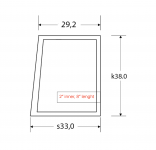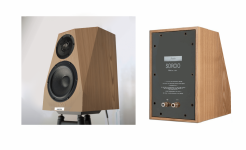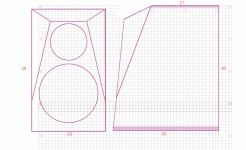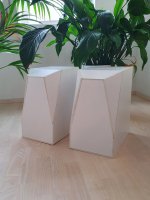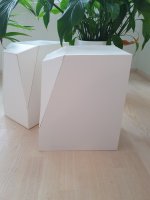Hi, the woofer in question is: Audio technology 18h52 17 06 SD
I have understood that QTS value 0,32 should go more as vented, but just curious could it actually work as sealed?
Im not worried that vented box will not work, since my volume/port length for woofer will be same as Jeff Bagby´s Spirit Winds.
Just curious since i know i will be using high quality subwoofer anyway, could i stuff it and try to see do i like actually sealed bass better.
I have understood that QTS value 0,32 should go more as vented, but just curious could it actually work as sealed?
Im not worried that vented box will not work, since my volume/port length for woofer will be same as Jeff Bagby´s Spirit Winds.
Just curious since i know i will be using high quality subwoofer anyway, could i stuff it and try to see do i like actually sealed bass better.
Attachments
15,5L or 0.55 Cubic foot.+1 😉 Max flat vented is ~13.27 L/50.2 Hz Fb w/3" dia. x 12.72" vent for 150 W power handling, sealed it's ~0.57 Qtc/71 Hz Fc, ~10 W.
Your cab's net volume (Vb)?
Btw just for interest: Here are some box plans, photoshop mockups + foamcore box for measuring/prototyping crossover
Attachments
Last edited:
Hi, can i ask someone to explain me does Lynn Olson mean by saying that only "symmetrical" crossover relations are inphase?
1: Like woofer 2:th order and tweeter 2:th order or woofer 4:th order and tweeter 4:th order
or can nonsymmetrical also be inphase:
2: Woofer 2:th order nad tweeter 4:th order?
"
If the acoustical crossover is an inphase type (acoustical 2nd or 4th-order), and attention is paid to cabinet diffraction, the locked-in single-driver impression can be as strong as a physical single driver. You can walk right up to it and it still sounds like a single driver. At least my speakers turn out that way, and other folks seem to be able to do this as well. In a way, it mirrors the requirements for a good mono speaker - don't annoy the listener with spurious spatial impressions.
I don't doubt acoustical 3rd-order crossovers can be done well, but I haven't had as much luck with them - managing the spatial impression is more difficult, and small ripples in the response seem to stand out more. A possible reason for the subjective impression might be the inter-driver phase angle is already at 90 degrees, and small departures from the ideal curve spread it into the danger region of 120 degrees, where unpleasant out-of-phase impressions start.
By contrast, with an inphase crossover, a small departure from the ideal curve only results in a 30-degree phase spread, which doesn't sound all that different than zero degrees. When the phase spread goes from 90 to 120 degrees, though, you can actually start to hear odd flanging and acoustic-null sounds. I recognize them immediately as what they are, but to a listener that doesn't have a background in phase-shift networks and what they sound like, it sounds like a hard-to-pin-down coloration that doesn't have an obvious tonal center. Switching from music to wideband pink-noise gives the game away; pink-noise immediately reveals phasiness for what it is. With music the coloration comes and goes, and is very difficult to pin down. If the spectrum is sparse, you might not hear it all."
-This will help my to narrow what kind of test crossovers i will try to make match in phase in vituixcad, thank you!
1: Like woofer 2:th order and tweeter 2:th order or woofer 4:th order and tweeter 4:th order
or can nonsymmetrical also be inphase:
2: Woofer 2:th order nad tweeter 4:th order?
"
If the acoustical crossover is an inphase type (acoustical 2nd or 4th-order), and attention is paid to cabinet diffraction, the locked-in single-driver impression can be as strong as a physical single driver. You can walk right up to it and it still sounds like a single driver. At least my speakers turn out that way, and other folks seem to be able to do this as well. In a way, it mirrors the requirements for a good mono speaker - don't annoy the listener with spurious spatial impressions.
I don't doubt acoustical 3rd-order crossovers can be done well, but I haven't had as much luck with them - managing the spatial impression is more difficult, and small ripples in the response seem to stand out more. A possible reason for the subjective impression might be the inter-driver phase angle is already at 90 degrees, and small departures from the ideal curve spread it into the danger region of 120 degrees, where unpleasant out-of-phase impressions start.
By contrast, with an inphase crossover, a small departure from the ideal curve only results in a 30-degree phase spread, which doesn't sound all that different than zero degrees. When the phase spread goes from 90 to 120 degrees, though, you can actually start to hear odd flanging and acoustic-null sounds. I recognize them immediately as what they are, but to a listener that doesn't have a background in phase-shift networks and what they sound like, it sounds like a hard-to-pin-down coloration that doesn't have an obvious tonal center. Switching from music to wideband pink-noise gives the game away; pink-noise immediately reveals phasiness for what it is. With music the coloration comes and goes, and is very difficult to pin down. If the spectrum is sparse, you might not hear it all."
-This will help my to narrow what kind of test crossovers i will try to make match in phase in vituixcad, thank you!
- Home
- Loudspeakers
- Multi-Way
- If i make vented speaker, will it work as "properly" sealed speaker as well? QTS 0,32

